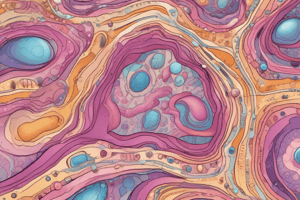Podcast
Questions and Answers
What are the three embryonic germ layers from which epithelia originate?
What are the three embryonic germ layers from which epithelia originate?
Ectoderm, mesoderm, endoderm
Epithelia are avascular and receive nourishment by diffusion through the basement membrane.
Epithelia are avascular and receive nourishment by diffusion through the basement membrane.
True (A)
What term describes epithelia consisting of a single cell layer?
What term describes epithelia consisting of a single cell layer?
- Simple (correct)
- Pseudostratified
- Stratified
- Transitional
Pseudostratified epithelia are composed of ______ cell layer(s).
Pseudostratified epithelia are composed of ______ cell layer(s).
What is the classification of epithelia with more than one cell layer?
What is the classification of epithelia with more than one cell layer?
Match the type of epithelium with its typical location:
Match the type of epithelium with its typical location:
Flashcards are hidden until you start studying
Study Notes
Overview of Epithelia
- Epithelia arise from all three embryonic germ layers and cover internal surfaces and external body surfaces, excluding specialized regions like tooth surfaces and articular cartilages.
Structure of Epithelia
- Composed of closely packed cells with minimal extracellular space, providing a barrier and functional role.
- Exhibit polarity with three distinct domains: apical (top), lateral (sides), and basal (bottom or basolateral).
- Avascular, receiving nutrients through diffusion from the basement membrane that separates them from underlying connective tissue.
Classification of Epithelia
- Epithelia classified based on the number of cell layers and the shape of superficial cells.
- Simple epithelia have one cell layer; each cell contacts the basement membrane.
- Stratified epithelia consist of multiple layers; only the deepest layer contacts the basement membrane.
- Pseudostratified epithelia appear multilayered but consist of a single layer where all cells touch the basement membrane.
Types of Epithelia
-
Simple Epithelia Types:
- Simple Squamous: Found in endothelium (blood vessels) and mesothelium (lining body cavities).
- Simple Cuboidal: Located in kidney distal tubules and some gland ducts, as well as the ovarian surface.
- Simple Columnar: Present in the lining of the intestine, stomach, and excretory ducts.
- Pseudostratified Columnar: Found in trachea, bronchi, nasal cavity, and parotid gland ducts; appears stratified due to differing cell heights.
-
Stratified Epithelia Types:
- Stratified Squamous (Keratinized): Composed of flattened dead cells, located in the epidermis of the skin.
- Stratified Squamous (Non-Keratinized): Lining of esophagus, vagina, mouth, and true vocal cords, featuring nucleated cells.
- Stratified Cuboidal: Generally found in ducts of sweat glands and larger excretory glands.
- Stratified Columnar: Rare, located in larger ducts of some glands and cavernous urethra.
-
Transitional Epithelium: Unique shape varying between dome-shaped (relaxed) and flattened (stretched), found lining urinary passages from renal calyces to the urethra.
Studying That Suits You
Use AI to generate personalized quizzes and flashcards to suit your learning preferences.




